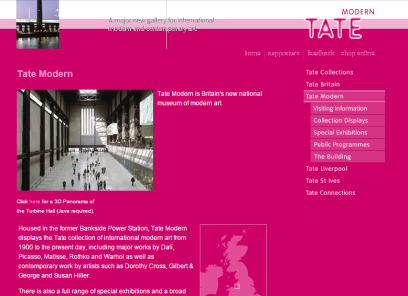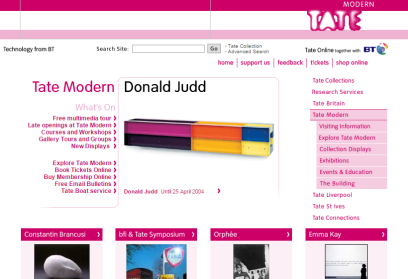Recently I visited Tate Modern to see The World Goes Pop exhibition. Having been to the Southbank site many times, I was already familiar with the commanding brick façade and vast interior spaces. Approaching the building from the riverside, you are faced with a very wide, very high wall; the people standing on the balconies above seem tiny and lost against the brick and glass. This imposing – and slightly intimidating – architecture of the converted power station could be seen as a reflection of the Tate’s significant and dominant presence in the art world. The entrance is indicated by signs for the current exhibitions and, as it was a Saturday afternoon, there were crowds aplenty.
Once inside, just past the gift shop, there was a lady in a bright coloured t-shirt standing with a clipboard, ready to give directions and answer questions. As the Turbine Hall was closed off for installation work, there were a lot of confused visitors blocking the doorways, trying to navigate to their chosen destination. With seven floors, there is a lot of ground to cover and this can seem quite daunting to both new and regular visitors alike. Despite the floor number being visible on both the stairwell and the lifts, it can be quite disconcerting trying to navigate the near-identical levels. Further still, the escalators only join alternating floors, which isn’t always apparent until it’s too late to step off. Tate tries to encourage use of the stairs to prevent over-crowding at the lifts, but this too can prove tricky as they are quite steep and narrow. In terms of signage, there are wall-mounted directions, and the occasional stand with purchasable maps. I don’t recall seeing many members of staff.
The Tate’s website, on the other hand, is much more straight-forward and traffic-free. With its white backgrounds and dark grey font (colour is reserved for images and the occasional underlining and highlighting), it is clean-cut, coherent, and easy to navigate. Each specific Tate site is given the same treatment, promoting a sense of unity and – perhaps more significantly for them – a cohesive brand, with the recognisable logo emblazoned at the top of every page. The drop-down column on the far left hand side replaces the lady in the bright t-shirt. It states clear headings, covering everything from opening times and school visits, to a comprehensive history of the Turbine Hall. It even has options for viewing the pages in French, German, Spanish, and Italian.
This current design was employed following a complete overhaul of the website in April 2012, as part of the 2010-2012 Online Strategy initiative (also coinciding with the revamp of Tate Britain). Using the Wayback Machine, it is curious to see the development of the site leading up to this point.
In the year 2000, when Tate Modern first opened its physical – and digital – doors, the websites used bright colours to distinguish between the four different sites. These colours formed the main background for the overlaying white text (which, for me personally, makes the writing very difficult to read). The detailed information given is almost identical to that displayed on the current website, under similar – if not the same – title headings.
2004 saw a layout change wherein the images and text were more bunched together. Combined with the bright coloured backgrounds, the overall look was rather cluttered and disjointed. It was interesting to note the flags of alternative languages available to visitors, including British Sign Language. It’s understandable that as the contents of the website grows, it is near impossible to translate everything into every language, however it is a shame that BSL no longer seems to be included (or, if it is, it is not as easily visible on the homepage).
In some respects, a museum’s engagement with digital practice can be viewed as a comment on how they view themselves as an institution (as argued by Lianne McTavish). If a museum has an extensive array of digital activities, it suggests that this is an institution that pushes the boundaries of their basic role.
Although the definition of the “proper” role of a museum is constantly shifting, there is an expected duty to build and maintain a relationship with the public. Having a digital presence provides another platform on which this can be achieved, enabling further levels of didactic interaction with the collections. As museums are adapting to keep up-to-date with new generations and maintain relevance in an increasingly digital society, employing such techniques show a willingness to branch out and try new means of engagement.
The Tate is currently undergoing a transformation, aiming to integrate digital practice within every department. As dominating as this sounds, the digitisation is set to work in ‘parallel’ with its current work, not replace it. John Stack referred to the Tate’s website as being its ‘fifth site’, as great or important as any of the physical buildings. McTavish argues, however, that some museum websites are paradoxical because they seem to have contradictory aims, not unlike museums themselves [McTavish, 2006, p.229]. They seem to be confused with what they want to achieve and the overall impact this will have, losing their way in the process. Although this may be true of some museums, Tate’s strategy seems to have been well thought out in relation to their mission as an institution and the kind of audiences they are playing to.
Digital literacy and understanding will be a significant contributor to its success. Stack emphasised that such plans are often met with resistance from certain members of staff who are unfamiliar with social media/blogs/etc and are therefore reluctant to change their practice. For this reason, careful planning needs to take place before engaging too heavily in the digital. By trying to become more inclusive for online audiences, there is a risk of excluding those offline. Not everyone is happy to embrace the digital, nor have the skills to do so.
For example, a museum that relies on retired volunteers to operate will not have the same capacity to branch out into the digital world. A tiny local museum I worked for a few years ago has only recently switched from dial-up internet to broadband. Even though sites such as Facebook and Twitter are free to access, you still need the familiarity and computer-confidence to use them effectively. An outdated, non-flashy website is perhaps commonplace for an outdated, non-flashy museum, but it doesn’t mean this is how the museum views itself. It may wish to get more involved but does not have the means to do so.
“In order to create a more joined-up approach to audiences, we need to connect our online audiences with our offline audiences…” (Finnis, Chan, and Clements, 2011, p.5.)
It may be easier said than done, but I agree with this to an extent. A good website and online presence may help to bring together a museum’s audience (both existing and potential), and can bring great benefits to the work of the institution and enhance its visitors’ experience.
However, it is worth remembering that every museum is unique, and will therefore need to devise strategies that are suited for their individual goals and requirements, as well as the needs for their particular audience. It might be too easy to delve into the digital world without having a set intention for what you want to achieve. Perhaps if a museum’s typical audience is generally ‘offline’ (being in a town with a largely retired population, for example), there is little need to invest heavily in technological practice. It could be used for advertisement or as a way of reaching out to younger generations but, depending on the individual circumstances, this might not be a beneficial use of resources.
So yes, in essence, connecting audiences through the shared medium of technology may result in a more all-encompassed work practice, but this will not necessary apply to everyone. Perhaps it will become clearer as we look at more case studies throughout the module, but the relationship between a museum and it digital work is bigger and more complex than it initially seems…
Are small museums in danger of being left behind during the impending digital revolution?
Should more be done to teach museum staff about ways of communicating online, and how to utilise this in order to reach out to the public and build on the museum/visitor relationship?
References:
Finnis, J., Chan, S., Clements, R. 2011. How to evaluate online success? [http://www.keepandshare.com/doc/3148919/culture24‐ howtoevaluateonlinesuccess‐bw‐pdf‐september‐19‐2011‐11‐15‐ am‐2‐1‐meg?da=y], accessed 08 October 2015.
McTavish, L. 2006. ‘Visiting the Virtual Museum: Art and Experience Online’. In Marstine, J., (ed) New Museum Theory and Practice: An Introduction. Oxford: Blackwell.
Stack, J. Spring 2013. ‘Tate Digital Strategy 2013–15: Digital as a Dimension of Everything’, in: Tate Papers, no.19, [http://www.tate.org.uk/research/publications/tate-papers/19/tate-digital-strategy-2013-15-digital-as-a-dimension-of-everything], accessed 10 October 2015.
Stack, J. Spring 2010. ‘Tate Online Strategy 2010–12’, in: Tate Papers, no.13, [http://www.tate.org.uk/research/publications/tate-papers/13/tate-online-strategy-2010-12], accessed 10 October 2015.
Stack, J. ‘The Digital Museum’, presentation given 03 November 2014.
Unknown. Date unknown. About Tate’s Website [http://www.tate.org.uk/about/our-work/digital/about-website], accessed 10 October 2015.



